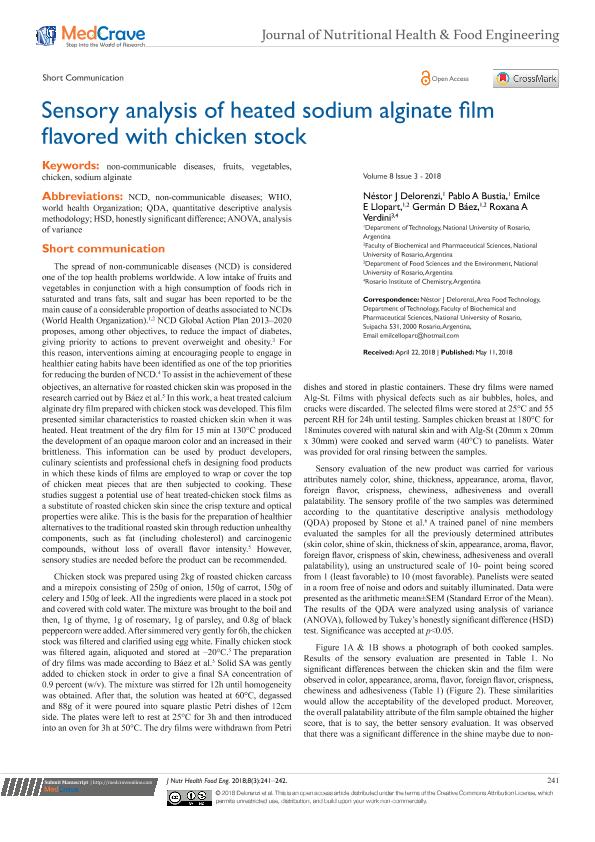Mostrar el registro sencillo del ítem
dc.contributor.author
Delorenzi, Nestor Jorge

dc.contributor.author
Busti, Pablo Andres

dc.contributor.author
Llopart, Emilce Elina

dc.contributor.author
Báez, Germán David

dc.contributor.author
Verdini, Roxana Andrea

dc.date.available
2020-02-17T19:16:02Z
dc.date.issued
2018-05
dc.identifier.citation
Delorenzi, Nestor Jorge; Busti, Pablo Andres; Llopart, Emilce Elina; Báez, Germán David; Verdini, Roxana Andrea; Sensory analysis of heated sodium alginate film flavored with chicken stock; MedCrave ; Journal of Nutritional Health & Food Engineering; 8; 3; 5-2018; 241-242
dc.identifier.issn
2373-4310
dc.identifier.uri
http://hdl.handle.net/11336/97795
dc.description.abstract
The spread of non-communicable diseases (NCD) is considered one of the top health problems worldwide. A low intake of fruits and vegetables in conjunction with a high consumption of foods rich in saturated and trans fats, salt and sugar has been reported to be the main cause of a considerable proportion of deaths associated to NCDs (World Health Organization (WHO), 2009; WHO, 2011). NCD Global Action Plan 2013?2020 proposes, among other objectives, to reduce the impact of diabetes, giving priority to actions to prevent overweight and obesity (WHO, 2016). For this reason, interventions aiming at encouraging people to engage in healthier eating habits have been identified as one of the top priorities for reducing the burden of NCD (Beaglehole et al., 2011). To assist in the achievement of these objectives, an alternative for roasted chicken skin was proposed in the research carried out by Báez et al. (2017). In this work, a heat treated calcium alginate dry film prepared with chicken stock was developed. This film presented similar characteristics to roasted chicken skin when it was heated. Heat treatment of the dry film for 15 min at 130 °C produced the development of an opaque maroon color and an increased in their brittleness. This information can be used by product developers, culinary scientists and professional chefs in designing food products in which these kinds of films are employed to wrap or cover the top of chicken meat pieces that are then subjected to cooking. These studies suggest a potential use of heat treated-chicken stock films as a substitute of roasted chicken skin since the crisp texture and optical properties were alike. This is the basis for the preparation of healthier alternatives to the traditional roasted skin through reduction unhealthy components, such as fat (including cholesterol) and carcinogenic compounds, without loss of overall flavor intensity (Báez et al., 2017). However, sensory studies are needed before the product can be recommended.
dc.format
application/pdf
dc.language.iso
eng
dc.publisher
MedCrave
dc.rights
info:eu-repo/semantics/openAccess
dc.rights.uri
https://creativecommons.org/licenses/by-nc/2.5/ar/
dc.subject
NON-COMMUNICABLE DISEASES
dc.subject
VEGETABLES
dc.subject
CHICKEN
dc.subject
SODIUM ALGINATE
dc.subject.classification
Alimentos y Bebidas

dc.subject.classification
Otras Ingenierías y Tecnologías

dc.subject.classification
INGENIERÍAS Y TECNOLOGÍAS

dc.title
Sensory analysis of heated sodium alginate film flavored with chicken stock
dc.type
info:eu-repo/semantics/article
dc.type
info:ar-repo/semantics/artículo
dc.type
info:eu-repo/semantics/publishedVersion
dc.date.updated
2020-01-29T22:34:15Z
dc.identifier.eissn
2373-4310
dc.journal.volume
8
dc.journal.number
3
dc.journal.pagination
241-242
dc.journal.pais
Estados Unidos

dc.description.fil
Fil: Delorenzi, Nestor Jorge. Universidad Nacional de Rosario. Facultad de Ciencias Bioquímicas y Farmacéuticas. Departamento de Tecnología; Argentina
dc.description.fil
Fil: Busti, Pablo Andres. Consejo Nacional de Investigaciones Científicas y Técnicas; Argentina. Universidad Nacional de Rosario. Facultad de Ciencias Bioquímicas y Farmacéuticas. Departamento de Tecnología; Argentina
dc.description.fil
Fil: Llopart, Emilce Elina. Consejo Nacional de Investigaciones Científicas y Técnicas. Centro Científico Tecnológico Conicet - Rosario; Argentina. Universidad Nacional de Rosario. Facultad de Ciencias Bioquímicas y Farmacéuticas. Departamento de Tecnología; Argentina
dc.description.fil
Fil: Báez, Germán David. Universidad Nacional de Rosario. Facultad de Ciencias Bioquímicas y Farmacéuticas. Departamento de Tecnología; Argentina. Consejo Nacional de Investigaciones Científicas y Técnicas. Centro Científico Tecnológico Conicet - Rosario; Argentina
dc.description.fil
Fil: Verdini, Roxana Andrea. Consejo Nacional de Investigaciones Científicas y Técnicas. Centro Científico Tecnológico Conicet - Rosario. Instituto de Biología Molecular y Celular de Rosario. Universidad Nacional de Rosario. Facultad de Ciencias Bioquímicas y Farmacéuticas. Instituto de Biología Molecular y Celular de Rosario; Argentina
dc.journal.title
Journal of Nutritional Health & Food Engineering
dc.relation.alternativeid
info:eu-repo/semantics/altIdentifier/url/http://medcraveonline.com/JNHFE/JNHFE-08-00277.php
dc.relation.alternativeid
info:eu-repo/semantics/altIdentifier/doi/http://dx.doi.org/10.15406/jnhfe.2018.08.00277
Archivos asociados
